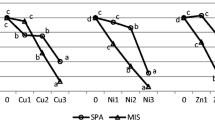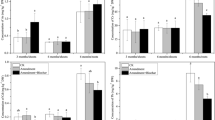Abstract
Phytoremediation of contaminated mine soils requires the use of fast-growing, deep-rooted, high-biomass, and metal-tolerant plants with the application of soil amendments that promote metal uptake by plants. A pot experiment was performed to evaluate the combined use of vetiver grass (Chrysopogon zizanioides) and humic acid for phytoremediation of Cu and Zn in mine soils. Vetiver plants were grown in soil samples collected from two mine sites of Spain mixed with a commercial humic acid derived from leonardite at doses of 0, 2, 10, and 20 g kg−1. Plant metal concentrations and biomass were measured and metal bioavailability in soils was determined by a low molecular weight organic acid extraction. Results showed that humic acid addition decreased organic acid-extractable metals in soil. Although this extraction method is used to estimate bioavailability of metals, it was not a good estimator under these conditions due to competition with the strong chelators in the added humic acid. High doses of humic acid also promoted root growth and increased Cu concentrations in plants due to formation of soluble metal-organic complexes, which enhanced removal of this metal from soil and its accumulation in roots. Although humic acid was not able to improve Zn uptake, it managed to reduce translocation of Zn and Cu to aerial parts of plants. Vetiver resulted unsuitable for phytoextraction, but our study showed that the combined use of this species with humic acid at 10–20 g kg−1 could be an effective strategy for phytostabilization of mine soils.



Similar content being viewed by others
References
Andra SS, Datta R, Sarkar D, Makris KC, Mullens CP, Sahi SV, Bach SBH (2009) Induction of lead-binding phytochelatins in vetiver grass [Vetiveria zizanioides (L.)]. J Environ Qual 38:868–877
Angin I, Turan M, Ketterings QM, Cakici A (2008) Humic acid addition enhances B and Pb phytoextraction by vetiver grass (Vetiveria zizanioides (L.) Nash). Water Air Soil Pollut 188:335–343
Ashworth DJ, Alloway DJ (2008) Influence of dissolved organic matter on the solubility of heavy metals in sewage-sludge-amended soils. Comm Soil Sci Plant Anal 39:538–550
Berghof (2008) Berghof application report microwave pressure digestion Speedwave four, food, pharma, cosmetics. Berghof Products + Instruments GmbH, Eningen
Chen Y, Shen Z, Li X (2004) The use of vetiver grass (Vetiveria zizanioides) in the phytoremediation of soils contaminated with heavy metals. Appl Geochem 19:1553–1565
Chen KF, Yeh TY, Lin CF (2012) Phytoextraction of Cu, Zn, and Pb enhanced by chelators with vetiver (Vetiveria zizanioides): hydroponic and pot experiments. ISRN Ecol 2012:1–12. doi:10.5402/2012/729693
Clemente R, Bernal MP (2006) Fractionation of heavy metals and distribution of organic carbon in two contaminated soils amended with humic acids. Chemosphere 64:1264–1273
Clemente R, Escolar A, Bernal P (2006) Heavy metals fractionation and organic matter mineralisation in contaminated calcareous soil amended with organic materials. Bioresource Technol 97:1894–1901
Council of the European Communities (1986) Council directive of 12 June 1986 on the protection of the environment, and in particular of the soil, when sewage sludge is used in agriculture. Off J Eur Communities L181:6–12
Danh LT, Truong P, Mammucari R, Tran T, Foster N (2009) Vetiver grass, Vetiveria zizanioides: a choice plant for phytoremediation of heavy metals and organic wastes. Int J Phytoremediat 11:664–691
Datta R, Quispe MA, Sarkar D (2011) Greenhouse study on the phytoremediation potential of vetiver grass, Chrysopogon zizanioides L., in arsenic-contaminated soils. Bull Environ Contam Toxicol 86:124–128
Day PR (1965) Particle fractionation and particle-size analysis. In: Black CA (ed) Methods of soil analysis, part 1. American Society of Agronomy, Madison, pp 545–567
El-Eswed B, Khalili F (2006) Adsorption of Cu(II) and Ni(II) on solid humic acid from the Azraq area, Jordan. J Colloid Interf Sci 299:497–503
Evangelou MWH, Daghan H, Schaeffer A (2004) The influence of humic acids on the phytoextraction of cadmium from soil. Chemosphere 57:207–213
Feng MH, Shan XQ, Zhang SZ, Wen B (2005a) A comparison of the rhizosphere-based method with DTPA, EDTA, CaCl2, and NaNO3 extraction methods for prediction of bioavailability of metals in soil to barley. Environ Pollut 137:231–240
Feng MH, Shan XQ, Zhang SZ, Wen B (2005b) Comparison of a rhizosphere-based method with other one-step extraction methods for assessing the bioavailability of soil metals to wheat. Chemosphere 59:939–949
Halim M, Conte P, Piccolo A (2003) Potential availability of heavy metals to phytoextraction from contaminated soils induced by exogenous humic substances. Chemosphere 52:265–275
Hattab N, Soubrand M, Guégan R, Motelica-Heino M, Bourrat X, Faure O, Bouchardon JL (2014) Effect of organic amendments on the mobility of trace elements in phytoremediated techno-soils: role of the humic substances. Environ Sci Pollut Res 21:10470–10480
International Standards Organization (1995) Soil quality: extraction of trace elements soluble in aqua regia, ISO 11466. International Organization for Standardization (ISO), Geneva
Kabata-Pendias A, Pendias H (2001) Trace elements in soils and plants. CRC Press, Boca Raton
Lasat MM, Pence NS, Garvin DF, Kochian LV (2000) Molecular physiology of zinc transport in the Zn hyperaccumulator Thlaspi caerulescens. J Exp Bot 51:71–79
Meeinkuirt W, Pokethitiyook P, Kruatrachue M, Tanhan P, Chaiyarat R (2012) Phytostabilization of a Pb-contaminated mine tailing by various tree species in pot and field trial experiments. Int J Phytoremediat 14:925–938
Mendez MO, Maier RM (2008) Phytoremediation of mine tailings in temperate and arid environments. Rev Environ Sci Biotechnol 7:47–59
Navarro MC, Pérez-Sirvent C, Martínez-Sánchez MJ, Vidal J, Tovar PJ, Bech J (2008) Abandoned mine sites as a source of contamination by heavy metals: a case study in a semi-arid zone. J Geochem Explor 96:183–193
Nelson DW, Sommers LE (1996) Total carbon, organic carbon, and organic matter. In: Sparks DL (ed) Methods of soil analysis, part 3. Chemical Methods. Soil Science Society of America and American Society of Agronomy, Madison, pp 961–1010
Paz-Alberto AM, Sigua GC, Baui BG, Prudente JA (2007) Phytoextraction of lead-contaminated soil using vetivergrass (Vetiveria zizanioides L.), cogongrass (Imperata cylindrica L.) and carabaograss (Paspalum conjugatum L.). Environ Sci Pollut Res 14:498–504
Prado AGS, Torres JD, Martins PC, Pertusatti J, Bolzon LB, Faria EA (2006) Studies on copper(II)- and zinc(II)-mixed ligand complexes of humic acid. J Hazard Mater B136:585–588
Rhoades JD (1982) Cation exchange capacity. In: Page AL et al (eds) Methods of soil analysis, part 2: chemical and microbiological properties, 2nd edn. American Society of Agronomy, Madison, pp 149–164
Rodríguez-Vila A, Asensio V, Forján R, Covelo EF (2015) Remediation of a copper mine soil with organic amendments: compost and biochar versus technosol and biochar. Spanish J Soil Sci 5:130–143
Shuman LM (1999) Organic waste amendments effect on zinc fractions of two soils. J Environ Qual 28:1442–1447
Tipping E (2002) Cation binding by humic substances. Cambridge University Press, Cambridge
Truong P (1999) Vetiver grass technology for mine rehabilitation. Tech Bull No. 1999/2. Pacific Rim Vetiver Network, Office of the Royal Development Projects Board, Bangkok
US Environmental Protection Agency (1996) Acid digestion of sediments, sludges and soils, Method 3050B. In: Test methods for evaluating solid waste, physical/chemical methods, SW-846. Environmental Protection Agency of United State of America (EPA), Washington, DC
Xu W, Li W, He J, Singh B, Xiong Z (2009) Effects of insoluble Zn, Cd, and EDTA on the growth, activities of antioxidant enzymes and uptake of Zn and Cd in Vetiveria zizanioides. J Environ Sci 21:186–192
Yang B, Shu WS, Ye ZH, Lan CY, Wong MH (2003) Growth and metal accumulation in vetiver and two Sesbania species on lead/zinc mine tailings. Chemosphere 52:1593–1600
Acknowledgements
The authors are grateful to Maria José Fernández Alonso for her assistance on the pot experiment and soil analyses. This work was financed by the Spanish Ministry of Economy and Competitiveness (project CTM2013-47874-C2-1-R).
Author information
Authors and Affiliations
Corresponding author
Additional information
Responsible editor: Elena Maestri
Rights and permissions
About this article
Cite this article
Vargas, C., Pérez-Esteban, J., Escolástico, C. et al. Phytoremediation of Cu and Zn by vetiver grass in mine soils amended with humic acids. Environ Sci Pollut Res 23, 13521–13530 (2016). https://doi.org/10.1007/s11356-016-6430-x
Received:
Accepted:
Published:
Issue Date:
DOI: https://doi.org/10.1007/s11356-016-6430-x




